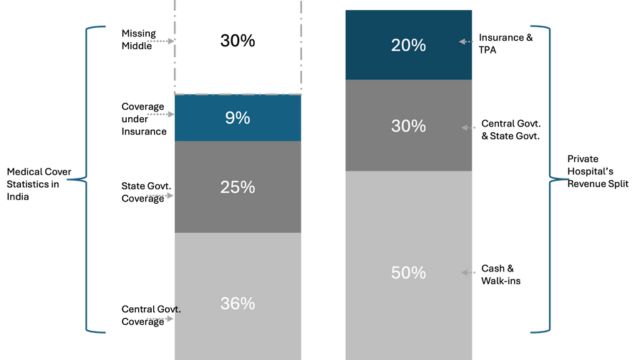Universal access to reasonably priced, high-quality healthcare continues to be a fundamental component of socioeconomic advancement in the rapidly changing field of public health. Globally, a number of health insurance models have developed over time to address the issues of accessibility, cost, and equity in healthcare delivery. Ayushman Bharat is one such ambitious plan that has garnered attention because to its goal to unify healthcare delivery, financing, and digital infrastructure under a single framework. It displays both encouraging parallels and structural differences when compared to well-established international health insurance plans.
Understanding the Conceptual Foundation

The idea of risk pooling, which distributes the financial risk of illness among a wide population to prevent any one person from bearing debilitating expenses alone, is at the core of any health insurance program. Whether through employer-based programs, government-sponsored initiatives, or private-public collaborations, the majority of worldwide models uphold this fundamental principle.
This universal idea is reflected in Ayushman Bharat, which seeks to shield people—particularly underprivileged groups—from unaffordable medical bills. By combining insurance coverage with wellness infrastructure, it aims to combine preventive and curative healthcare. Many global systems, on the other hand, vary their strategies according on historical background, demographic pressures, and economic structure.
Architecture for Design and Coverage
The designs of health insurance schemes differ greatly across the globe. While some implement a social health insurance (SHI) model financed by payroll contributions, others provide universal health coverage (UHC) financed by taxes. Additionally, there are voluntary and community-based insurance programs that serve rural or unorganised communities.
Ayushman Bharat’s framework offers predetermined financial coverage for hospitalisation and secondary/tertiary treatment in an effort to bridge the gap in healthcare access. It emphasises cashless transactions, digital authentication, and portability. However, we frequently observe wider coverage in global systems, encompassing not only hospitalisation but also behavioural health, diagnostics, maternity health, outpatient care, and even long-term rehabilitation services.
Digital Infrastructure’s Function
The incorporation of digital technologies is a new aspect of contemporary health insurance. To improve transparency and expedite delivery, many international models are rapidly integrating telemedicine, AI-driven diagnostics, electronic health records (EHRs), and health management systems.
The distinctive feature of the Ayushman Bharat concept is the integration of digital layers across the entire process, from claim processing to beneficiary verification. Real-time monitoring, fraud prevention, and data-driven policy decisions are made possible by this tech-first strategy. In contrast, a number of established insurance programs are still undergoing modernisation in order to meet the expectations of the modern digital world.
Sustainability and Finance
The foundation of any health insurance scheme is sustainable funding. Around the world, models usually depend on a combination of employer payments, government support, and individual premiums. Insurance-funded models run the danger of creating gaps for people outside of regular job arrangements, while tax-funded versions are frequently criticised for being inefficient or overtaxing the public coffers.
The conceptual framework of Ayushman Bharat allows for state-level flexibility while providing centralised budgetary support. The package-based pricing techniques, standard treatment recommendations, and cost-control procedures are in accordance with international best practices that seek to avoid needless costs while preserving the quality of care.
But in areas where more recent models may learn and change for long-term resilience, global systems with decades of experience have created complex risk adjustment, co-payment systems, and incentives for preventative treatment.
Equity and Inclusion
The level of equity and inclusion offered by health insurance plans is one of the most important indicators of their performance. The ability of successful global health insurance models to cover all population segments, irrespective of social class, geography, or income, is a defining characteristic. This encompasses marginalised communities, individuals with disabilities, and undocumented populations.
Ayushman Bharat’s targeted design, which aims to serve economically disadvantaged parts and assure portability across areas, is its comparative strength. However, international programs with universal mandates frequently provide a more comprehensive safety net that takes into account wider socioeconomic determinants of health like housing, nutrition, and education.
Challenges in Implementation
Notwithstanding admirable goals, issues with fraud prevention, provider scarcity, urban-rural inequality, and service quality plague both the Ayushman Bharat and international insurance models. Rising healthcare costs and patient unhappiness are problems for some systems, while underfunding or bureaucratic delays afflict others.
It is crucial to learn from international models and employ integrated strategies that include decentralised governance, community involvement, public-private partnerships, and health literacy initiatives. By using these tactics, implementation efficiency and system confidence can be greatly increased.
Moving Towards an International Best Practices Framework
When contrasting Ayushman Bharat with global health insurance systems, a rich learning environment rather than a competition is revealed. Every system, regardless of how developed or young, provides guidance for negotiating the intricate relationship between public health, economics, and policy.
With its targeted coverage, digital-first approach, Ayushman Bharat embodies the goals of a contemporary welfare state attempting to advance into an inclusive health future. On the other hand, global systems show how reforms over decades have developed, providing mature lessons in population health outcomes, stakeholder alignment, and regulation.
Conclusion
Adaptive models that use technology to its fullest potential, stay sensitive to local situations, and borrow best practices are the way of the future for healthcare. The answers must be as interwoven as the problems facing global health. The world gets closer to establishing universal health care as a human right rather than a privilege by researching, contrasting, and learning from various insurance programs, such as Ayushman Bharat.
Stay informed with Digital India MIB — your trusted source for in-depth insights on digital governance, public welfare schemes, and emerging tech initiatives. Explore authentic updates, expert analysis, and simplified content crafted for every citizen. Join us in shaping a digitally empowered future.




